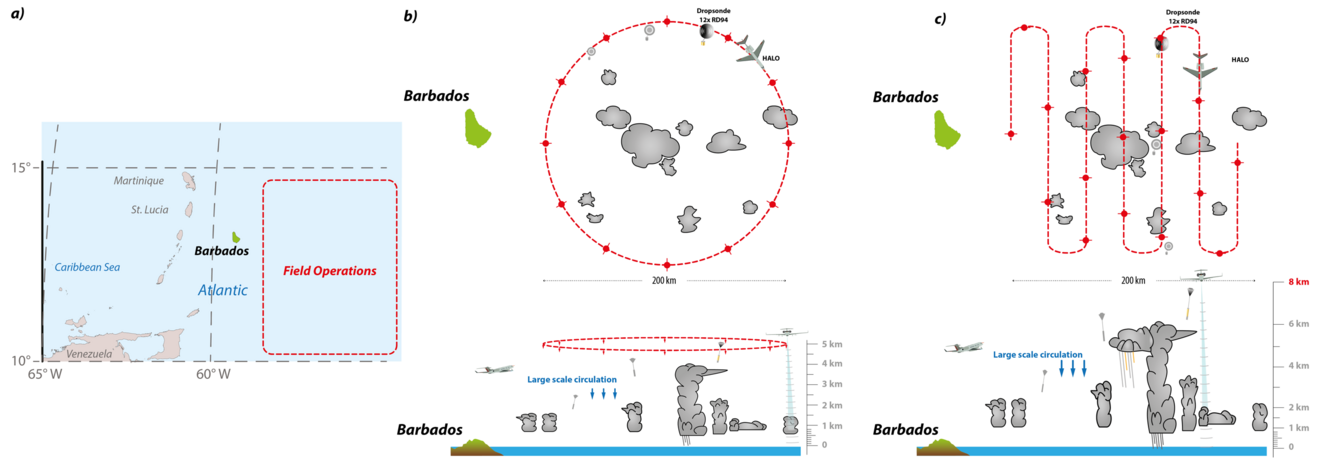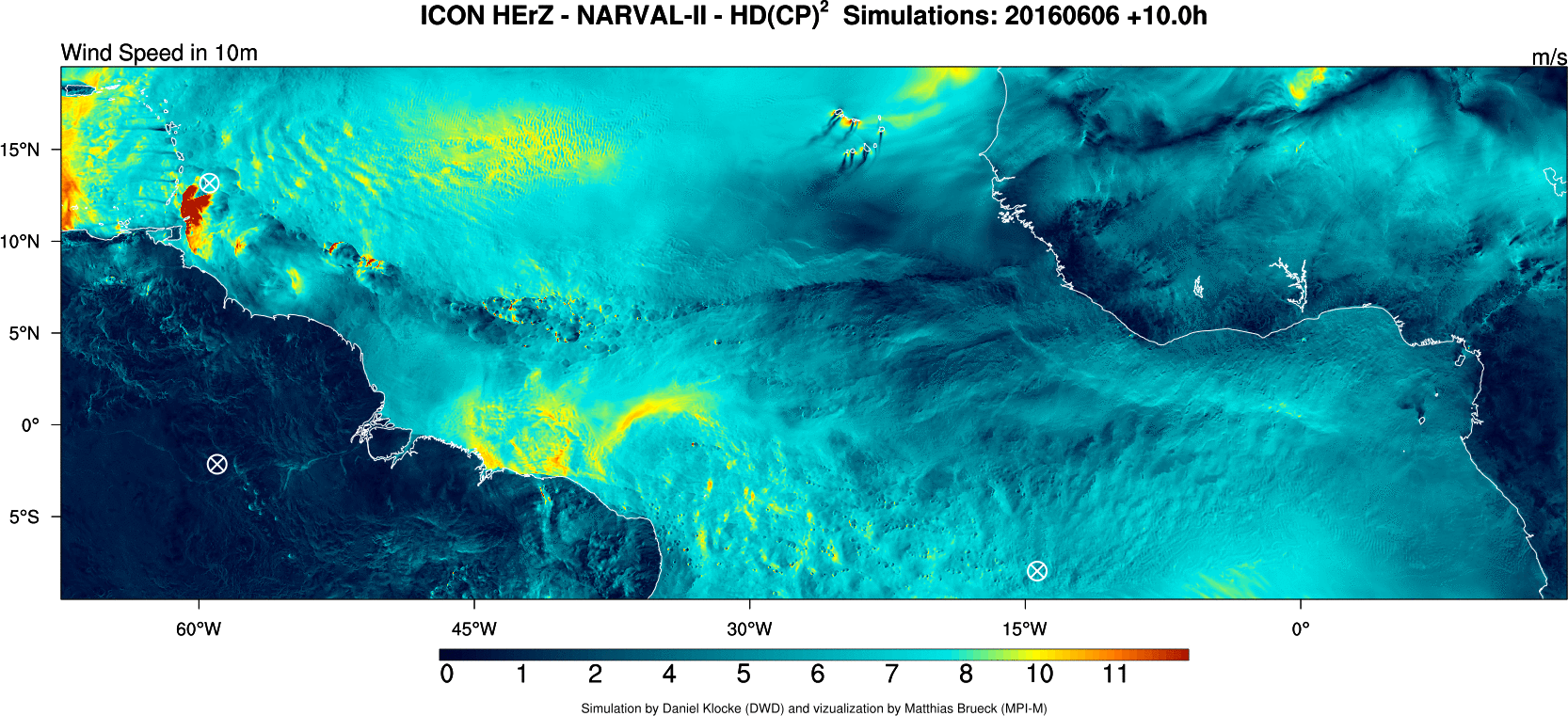Do clouds make the wind blow? Airborne investigations of the interplay between clouds and circulation
The field campaign NARVAL II, initiated and lead by scientists from the department The Atmosphere in the Earth System (Prof Bjorn Stevens) at the Max Planck Institute for Meteorology (MPI-M) and colleagues at the Universität Hamburg, aims to answer these questions. The NARVAL II mission started on 8 August 2016 with a ferry flight of the research aircraft HALO (High Altitude and Long Range Research Aircraft) from Oberpfaffenhofen, Germany, to Barbados.
NARVAL II is the second in a series of three planned missions supplementing a decade of ground-based measurements in the tropical Atlantic. It builds on insights from a predecessor campaign, NARVAL I, and is helping set the stage for an even larger international campaign within the French-German project EUREC4A, in February 2020. Three years after the first campaign NARVAL I (Next generation Aircraft Remote-sensing for Validation studies), the second campaign intensifies the focus on the coupling between clouds, circulation and climate over the tropical and subtropical ocean. NARVAL II will test the hypothesis that shallow, radiatively-driven, circulations support the tendency of convection to self-aggregate. Convective aggregation is a mysterious process whereby scattered convection congregates to form super-storms, and is thought to be important to understanding a great variety of tropical phenomena, from hurricanes to the Madden-Julian Oscillation.
NARVAL II will test these ideas by measuring how water vapor and clouds contribute to the intensity of low-level radiative cooling in the vicinity of convection, and the degree to which this is associated with a shallow circulation that transports moisture into the convective systems. These measurements will be facilitated by the intensive deployment of dropsondes over a large area, allowing for the mass, heat and moisture budgets to be measured.
The dropsondes, which are launched from the aircraft and descend by parachute, measure profiles of pressure, heat and moisture on their way through the atmosphere. The data they collect will help the scientists test new measurement strategies. These strategies will then be used to refine the experimental design for EUREC4A, whereby different platforms (ships and aircraft) will be available to simultaneously measure clouds and the large-scale environment in which they form.
In addition NARVAL II will help quantify the degree of ice and liquid condensate loading in tropical clouds, explore the role of the ice-phase in the life-cycle of cumulus clouds, and test retrievals being proposed for forthcoming satellite systems.
The NARVAL-ERUEC4A series of aircraft missions are centered over long-term ground-based measurements from the Barbados Cloud Observatory (BCO). The observatory, a cooperation of the MPI-M and the Caribbean Institute of Hydrology and Meteorology, is the only facility of its type in the greater tropics. It has been using advanced remote sensing to probe the tropical atmosphere and its clouds since 2010 and is at the center of a worldwide effort to unravel the mystery of how shallow convection responds to warming (see Stevens et al., 2016).
The aircraft HALO is equipped with HAMP (HALO Microwave Package), a package of measuring instruments designed to mimic the ground based measurements at the BCO. It consists of a microwave cloud radar, a water vapor differential absorption lidar, and three banks of microwave radiometers. All instruments are tailored to measuring water in the atmosphere in all its phases. In addition to HAMP spectral radiometers will be used to probe the microphysical structure of clouds, and dropsondes allow measurements of the atmospheric state, including winds, below the atmosphere. Measurements with HAMP and the BCO will also be central to evaluating EarthCARE (Earth Clouds, Aerosols and Radiation Explorer), a new Explorer Class satellite to be launched by the European Space Agency (ESA) and the Japan Aerospace Exploration Agency (JAXA), in 2019.
Flights during NARVAL II will be based out of Grantley Adams International Airport, Barbados. The ferry flights of HALO from Oberpfaffenhofen, and back again at the end of the deployment, will contribute to continue the validation studies of NARVAL I by adding a further characterization of the large-scale structure of the trades, and thus will include flying below satellite trajectories for comparative measurements as flight time allows. The main area of investigation is the vicinity of the Barbados Cloud Observatory, with areas of developing convective clusters determined on the basis of satellite imagery and analyses by the European Centre for Medium-Range Weather Forecasts (ECMWF). In total, eight nine-hour flights are envisaged.

The initial plan is to use two different types of flight patterns, but these might change as investigators adapt to knowledge won in the field. To measure developing convective clusters, HALO will fly repeated surveying-circles around developing convective clusters (figure b). To measure the deeper convection and its development, it will fly surveying-`mattress-spring' like patterns (figure c). The surveying-circles may be flown in the lower troposphere, to enable a greater density of dropsondes. The mattress-springs, on the contrary, will be flown at a greater flight level to allow for more sampling of the developing ice-phase. In the figure the flight level is shown at 8 km, but it may also be higher depending on the state of convection development. Ideally the convecting areas will be sampled on repeated days.
The NARVAL field campaign is supported by modelling activities through the Hans Ertel Center Research Group Clouds and Convection (Dr Cathy Hohenegger, MPI-M, and Dr Daniel Klocke, DWD) and the HD(CP)2 project (Dr Rieke Heinze and Matthias Brück). Through the support of these groups, DWD will provide simulations that are able to represent the convection over extensive areas with a resolution that is unprecedented. Who knows the simulations may even catch a hurricane in its early stages of development. But regardless, for the first time, from the small scales (a few isolated cells) to the large scales (organization across the entire Atlantic), the entire spectrum of cloud structures can be modeled without using parameterizations.

NARVAL is a joint project of Max Planck Institute for Meteorology, Universität Hamburg (group of Prof Felix Ament and Prof Stefan Bühler), University of Cologne, Leipzig University, Ludwig-Maximilian-Universität München, German Aerospace Center (Institute for Physics of the Atmosphere), and Laboratoire de Météorologique Dynamique in Paris.
The research aircraft HALO is an initiative by German climate and environmental research institutions. HALO is funded by: Federal Ministry of Education and Research (BMBF), German Research Foundation (DFG), Helmholtz Association, Max Planck Society, Leibniz Association, Free State of Bavaria, Karlsruhe Institute of Technology (KIT), GFZ German Research Centre for Geosciences, Forschungszentrum Jülich and German Aerospace Center (DLR).
Publications
Stevens, B., D. Farrell, L. Hirsch, F. Jansen, L. Nuijens, I. Serikov, B. Brügmann, M. Forde, H. Linné, K. Lonitz and J.M. Prospero (2016) The Barbados Cloud Observatory - Anchoring Investigations of Clouds and Circulation on the Edge of the ITCZ. Bull. AMS, 5, 787-801. doi: 10.1175/BAMS-D-14-00247.1
Illingworth et al. (2015) The EarthCARE Satellite - The next step forward in global measurements of clouds, aerosols, precipitation, and radiation. Bull. AMS, 8, 1311-1332. doi: 10.1175/BAMS-D-12-00227.1
Bony, S., Stevens, B., Frierson, D. M. W., Jakob, C., Kageyama, M., Pincus, R., et al. (2015). Clouds, circulation and climate sensitivity. Nature Geoscience, 8, 261-268. doi:10.1038/ngeo2398
Contact
Prof Dr Bjorn Stevens
Max Planck Institute for Meteorology
Phone: +49 40 41173 422 (Assistant Angela Gruber)
Email: bjorn.stevens@mpimet.mpg.de
Prof Dr Felix Ament
Universität Hamburg
Meteorological Institute
Phone: +49 40 42838 3597
Email: felix.ament@uni-hamburg.de

